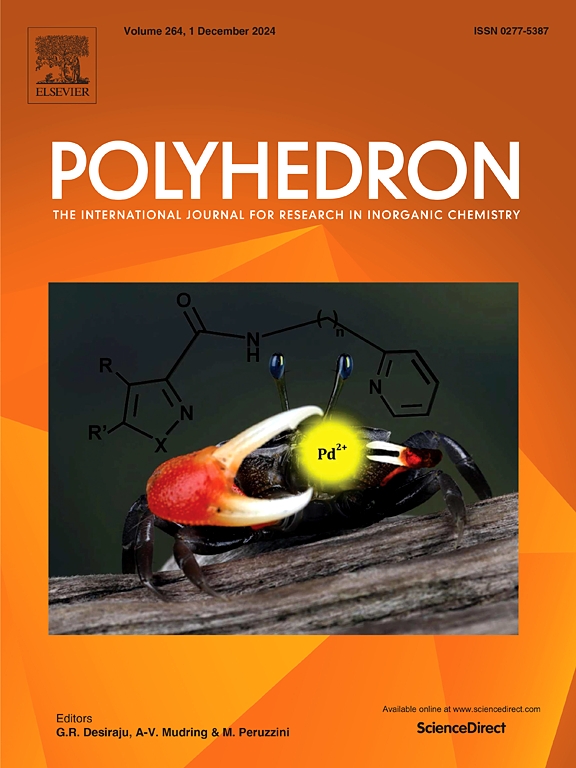Synthesis, characterization and theoretical studies of three similar nickel (II) complexes: Biological and photocatalytic applications
IF 2.4
3区 化学
Q2 CHEMISTRY, INORGANIC & NUCLEAR
引用次数: 0
Abstract
Three similar nickel(II) complexes [Ni(HL)L]Cl⋅2CH3OH⋅4H2O (1), [Ni(HL)L]NO3⋅3H2O (2) and [Ni(HL)L]Br⋅4H2O (3) of quinoline-2-carbaldehyde-N(4)-cyclohexylthiosemicarbazone (HL) were prepared and characterized physicochemically, while computational analysis was done by density functional theory (DFT). Metal ions are coordinated by the ligands in both neutral and mono deprotonated forms in all the complexes. In vitro and in silico antibacterial studies against Escherichia coli and Staphylococcus aureus have revealed the efficacy of the complexes compared to the free ligand. In vitro analysis showed higher activity of the chloride complex compared to the nitrate and bromide counterpart complexes. Also, the ligand HL and the complexes were examined for their in vitro cytotoxicity on MCF‐7 breast cancer cell line. The ligand with greater potency exhibits an IC50 value of 109.44 μM compared to complex 1 (IC50 360.55 μM), complex 2 (IC50 134.89 μM) and complex 3 (IC50 227.23 μM), which is also in agreement with in silico molecular docking study with DNA. The DNA binding studies of the complexes with CT-DNA confirm the groove mode of binding, while gel electrophoresis indicates endonucleolytic cleavage and fragmentation of DNA due to complex 1. Solid-state energy gaps of complexes 1–3 are evaluated through the Kubelka-Munk model, while intense charge transfer bands are also observed at ∼2.65 eV. Furthermore, the photocatalytic activity of HL and complexes were performed against methylene blue (MB) in presence of sunlight. After 120 min, the degradation efficiency of MB reached 22, 47, 58 and 55 % with HL and respective complexes 1, 2 and 3.

三种相似镍(II)配合物的合成、表征及理论研究:生物和光催化应用
采用密度泛函理论(DFT)对喹啉-2-碳酰胺- n(4)-环己基硫代氨基脲(HL)制备了3个相似的镍(II)配合物[Ni(HL)L]Cl⋅2CH3OH⋅4H2O(1)、[Ni(HL)L]NO3⋅3H2O(2)和[Ni(HL)L]Br⋅4H2O(3)进行了物理化学表征。金属离子在所有配合物中均以中性和单去质子形式与配体配位。体外和体内对大肠杆菌和金黄色葡萄球菌的抑菌研究表明,与游离配体相比,该配合物具有较好的抑菌效果。体外分析表明,氯化物配合物的活性高于硝酸盐和溴化物配合物。此外,还研究了配体HL和复合物对MCF‐7乳腺癌细胞株的体外细胞毒性。与配合物1 (IC50为360.55 μM)、配合物2 (IC50为134.89 μM)和配合物3 (IC50为227.23 μM)相比,该配体的IC50值为109.44 μM,与DNA的硅分子对接研究结果一致。复合物与CT-DNA的DNA结合研究证实了凹槽模式的结合,而凝胶电泳显示复合物1导致了DNA的核内溶分裂和断裂。通过Kubelka-Munk模型评估了配合物1-3的固态能隙,同时在~ 2.65 eV也观察到强烈的电荷转移带。此外,还研究了HL及其配合物在日光下对亚甲基蓝(MB)的光催化活性。经过120 min后,HL和配合物1、2、3对MB的降解效率分别达到22.0%、47.0%、58%和55%。
本文章由计算机程序翻译,如有差异,请以英文原文为准。
求助全文
约1分钟内获得全文
求助全文
来源期刊

Polyhedron
化学-晶体学
CiteScore
4.90
自引率
7.70%
发文量
515
审稿时长
2 months
期刊介绍:
Polyhedron publishes original, fundamental, experimental and theoretical work of the highest quality in all the major areas of inorganic chemistry. This includes synthetic chemistry, coordination chemistry, organometallic chemistry, bioinorganic chemistry, and solid-state and materials chemistry.
Papers should be significant pieces of work, and all new compounds must be appropriately characterized. The inclusion of single-crystal X-ray structural data is strongly encouraged, but papers reporting only the X-ray structure determination of a single compound will usually not be considered. Papers on solid-state or materials chemistry will be expected to have a significant molecular chemistry component (such as the synthesis and characterization of the molecular precursors and/or a systematic study of the use of different precursors or reaction conditions) or demonstrate a cutting-edge application (for example inorganic materials for energy applications). Papers dealing only with stability constants are not considered.
 求助内容:
求助内容: 应助结果提醒方式:
应助结果提醒方式:


